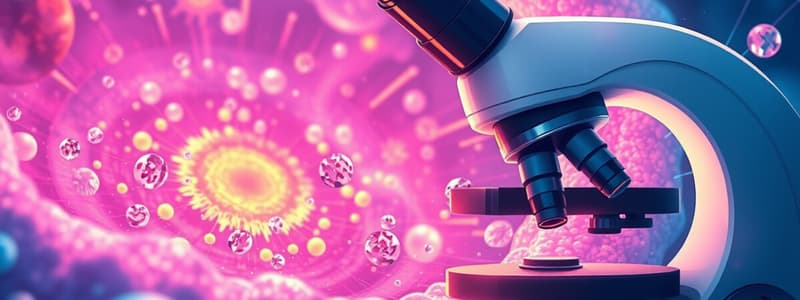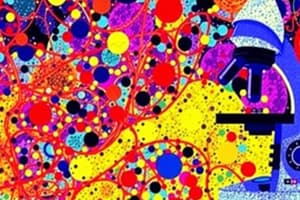Podcast
Questions and Answers
What is the primary function of microscopes in the study of cells?
What is the primary function of microscopes in the study of cells?
- To capture cells in motion
- To increase the size of cells for easier observation
- To eliminate the need for staining cells
- To help identify cell composition and contents (correct)
Which of the following is a characteristic of eukaryotic cells?
Which of the following is a characteristic of eukaryotic cells?
- They contain only ribosomes as organelles
- They are larger than prokaryotic cells
- Their nuclei are surrounded by a membrane (correct)
- They lack a nucleus entirely
Which organelles are specific to animal cells and not found in plant cells?
Which organelles are specific to animal cells and not found in plant cells?
- Mitochondria
- Endoplasmic reticulum
- Ribosomes
- Centrosomes and lysosomes (correct)
What distinguishes prokaryotic cells from eukaryotic cells?
What distinguishes prokaryotic cells from eukaryotic cells?
What are the basic components of a cell?
What are the basic components of a cell?
Which type of microscope is most appropriate for observing cell organelles?
Which type of microscope is most appropriate for observing cell organelles?
Which of the following statements is true about cellular organization?
Which of the following statements is true about cellular organization?
What is the range in size for most cells?
What is the range in size for most cells?
Flashcards are hidden until you start studying
Study Notes
Microscopes
- Microscopes are essential tools for viewing cells, which are too small to be seen with the naked eye.
- They enable the examination of cell contents that have a close refractive index, making identification difficult without assistance.
- Invented by Antonie van Leeuwenhoek (1591-1623).
- Types of microscopes include:
- Simple and compound light microscopes
- Contrast microscopes
- Fluorescent microscopes
- Field microscopes
- Electron microscopes
Meaning of a Cell
- A cell is the basic unit of life, invisible to the naked eye.
- Comprises three basic components: protoplasm, one or more nuclei, and an outer membrane or wall.
- Size is typically small, with the largest cells not exceeding 100 micrometers.
- Two main types of cells:
- Eukaryotic cells: Have membranes surrounding their nuclei; examples include cells in plants, fungi, and animals.
- Prokaryotic cells: Lack a membrane-bound nucleus; examples include bacteria and archaea.
Components of an Animal Cell
- Animal cells are the fundamental building blocks of animal bodies.
- Contain common organelles with plant cells, such as:
- Cell membrane
- Cytoplasm
- Nucleus
- Mitochondria
- Endoplasmic reticulum
- Golgi bodies
- Ribosomes
- Unique to animal cells:
- Centrosome
- Lysosomes
- Cilia
- Flagella
Cell Types
- Cells are categorized based on the presence of a nucleus:
- Prokaryotic cells (e.g., bacterial cells)
- Eukaryotic cells (e.g., animal and plant cells)
- Further classifications include somatic cells, sexual cells, and the cells that form organs, highlighting the complexity of cellular organization.
Studying That Suits You
Use AI to generate personalized quizzes and flashcards to suit your learning preferences.



